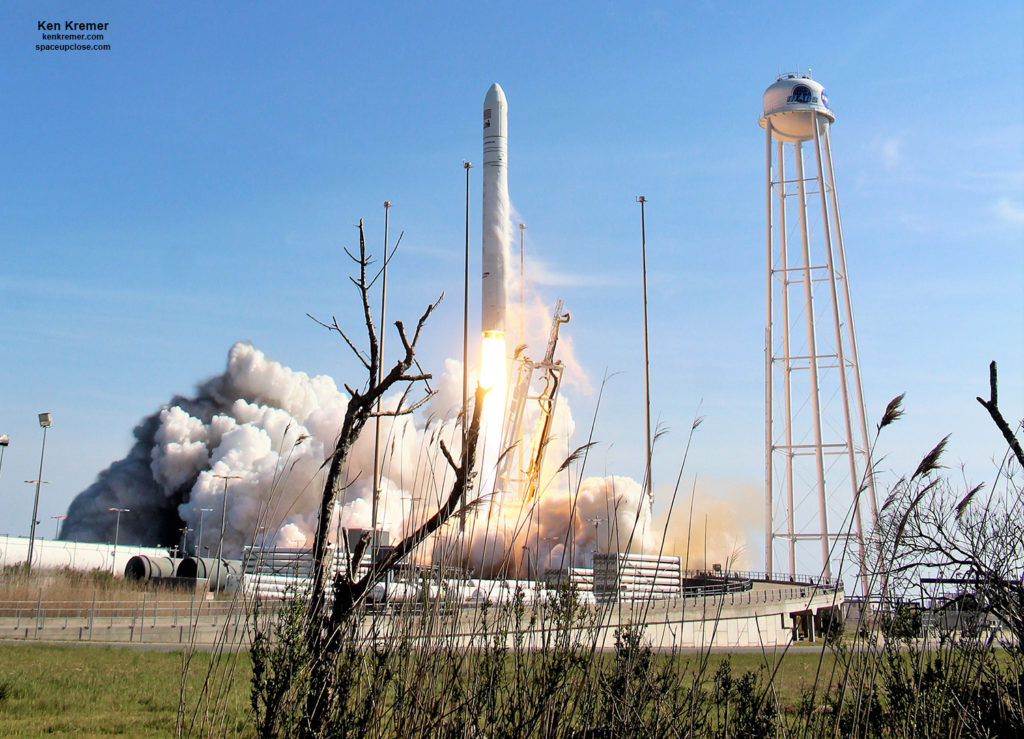 |
|
Antares and Nature blast off for space and the space station.
The Northrop Grumman Antares rocket, with Cygnus resupply spacecraft onboard, launches from Pad-0A, Wednesday, April 17, 2019 at NASA’s Wallops Flight Facility in Virginia. Northrop Grumman’s 11th contracted cargo resupply mission for NASA to the International Space Station will deliver about 7,600 pounds of science and research, crew supplies and vehicle hardware to the orbital laboratory and its crew. Credit: Ken Kremer/kenkremer.com/SpaceUpClose.com |
Kremer — SpaceUpClose.com &
RocketSTEM – 17 April 2019
beautiful afternoon blastoff of the Northrop Grumman Antares rocket from NASA
Wallops launch base on the Virginia shore – successfully delivering nearly 4
tons of new science and supplies to orbit aboard the commercial Cygnus supply
vessel bound for the International Space Station (ISS).
40 micetronauts, a robotic
astronaut helper, 63 thinsat free flying experiments from over 250 students and
a wide array of research is on its way to the ISS primed for rendezvous and
docking just a day and a half later early Friday morning, April 19.
The biggest crowd ever gathered
for an Antares launch witnessed the flawless performance put on by NASA’s
commercial cargo partner Northrop Grumman
as the rocket soared in its upgraded 230 configuration at 4:46 p.m. EDT (2046 GMT) Wednesday, April 17 from seaside Launch Pad 0A
at the Virginia Space Mid-Atlantic Regional Spaceport
(MARS) at NASA’s Wallops Flight Facility in Virginia.
Enjoy our gallery of
Space UpClose imagery of the launch.
Check back as the
story and gallery grows from my cameras ringing the launch pad as I’m in transit at the moment.
breaking crowd of well over 10,000 people trekked to the Wallops area for an up
close view – and they were not disappointed as the rockets engines roared to
life right on time.
4500 people alone
gathered at the NASA Wallops Visitor Center which reached capacity several
hours before liftoff with roads clogged and backed up for many miles around. Many
thousand more lined streets and watched from several nearby parks in the Chincoteague
local area.
also packed aboard Cygnus for the first time as a result on upgraded capabilities
introduced for the first time this mission.
photos to follow as I’m in transit for the moment.
The 14 story tall commercial expendable Antares launch vehicle
is launching in the upgraded and more powerful re-engined 230 configuration rocket
compared to the original version.
The first stage is powered by two newly built Russian-built
NPO Energomash RD-181 engines with independent thrust vectoring and fires for 3
minutes and 35 seconds before separating from the upper stage. They are test
fired by Energomash in Russia and shipped to Wallops.
They produce about 860,000 pounds of thrust, roughly 100,000
more thrust than the original Antares 100 configuration. They are throttled
down at Max Q to maintain core integrity.
The second stage comprises the Castor 30XL solid
rocket motor producing approximately107,000 pounds of thrust. It burns
for about 156 seconds.
The two stage Antares measures 139 feet (42.5 m)
tall and 13 feet (3.9 m) in diameter.
It has a payload capacity of 18,000 pounds (8,000 kg) to
low Earth orbit (LEO).
This delivery, Northrop Grumman’s 11th cargo
flight to the space station under NASA’s Commercial Resupply Services contract,
will support dozens of new and existing investigations. Here are details about
some of the scientific investigations Cygnus is delivering to the space
station:
materials
Advanced Colloids Experiment-Temperature-10 (ACE-T-10)
will test gels in a microgravity environment. This research could aid in the
development of increasingly complex materials that may serve as the building
blocks for a range of applications on Earth including foods, drugs, and
electronic devices. The process also may provide an efficient method to build
new materials and equipment in space.
Although the space station is well equipped for health and life sciences
research, the equipment available for cellular and molecular biology still is
limited compared to capabilities found in laboratories on Earth. To address
this limitation, CSA designed Bio-Analyzer,
a new tool the size of a video game console that astronauts on station easily
can use to test body fluids such as blood, saliva, and urine, with just a few
drops. It returns key analyses, such as blood cell counts, in just two to three
hours, eliminating the need to freeze and store samples.
The Vascular Aging
investigation uses ultrasounds, blood samples, oral glucose tolerance tests,
and wearable sensors to study aging-like changes that occur in many astronauts
during their stay on the space station. It’s one of three Canadian experiments
exploring the effects of weightlessness on the blood vessels and heart, and the
links between these effects and bone health, blood biomarkers, insulin
resistance, and radiation exposure. Increased understanding of these mechanisms
can be used to address vascular aging in both astronauts and the aging Earth
population.
Spaceflight is known to have a dramatic influence on an astronaut’s immune
response, but there is little research on its effect following an actual
challenge to the body’s immune system. The rodent immune system closely
parallels that of humans, and Rodent
Research-12: Tetanus Antibody Response by B cells in Space (TARBIS)
will examine the effects of spaceflight on the function of antibody production
and immune memory. This investigation aims to advance the development of
measures to counter these effects and help maintain crew health during future
long-duration space missions. On Earth, it could advance research to improve
the effectiveness of vaccines and therapies for treating diseases and cancers.
A fleet of small robots is set to take on big jobs aboard the space station.
Building on the success of SPHERES,
NASA will test Astrobee,
a robotic system comprised of three cube-shaped robots and a docking station
for recharging; the first two are aboard Cygnus. The free-flying robots use
electric fans for propulsion and cameras and sensors help them navigate their
surroundings. The robots also have an arm to grasp station handrails or grab
and hold items. Astrobee can operate in automated mode or under remote control
from the ground as it assists with routine chores on station, and requires no
supervision from the crew. This has the potential to free up astronauts to
conduct more research.
that will help us learn how to keep astronauts healthy during long-duration
space travel and demonstrate technologies for future human and robotic
exploration beyond low-Earth orbit to the Moon and Mars. Space
station research also provides opportunities for other U.S. government
agencies, private industry, and academic and research institutions, to conduct
microgravity research that leads to new technologies, medical treatments, and
products that improve life on Earth.
Chaffee, will arrive at the space station Friday, April 19.
At about 5:30 a.m., Expedition 59 astronauts Anne McClain
of NASA and David Saint-Jacques of the Canadian Space Agency (CSA) will use the
space station’s Canadian -built robotic arm to grapple and capture Cygnus,
while NASA’s Nick Hague
monitors telemetry during its approach.
After capture, ground controllers will command
the station’s arm to rotate and install Cygnus on the bottom of the station’s
Unity module.
a.m. and Cygnus installation coverage will begin at 7 a.m. April 19 on NASA
Television and the agency’s website.
The Cygnus spacecraft is scheduled to remain at
the space station for about 3 months until July 23, 2019, when it will depart
the station, deploy NanoRacks customer CubeSats, and then have an extended
mission until December 2019 before it will dispose of several tons of trash
during a fiery reentry into Earth’s atmosphere.
Grumman’s CRS-1 contract with NASA before starting the CRS-2 contract missions
in the fall of 2019. Under Northrop Grumman’s Commercial
Resupply Services contract, the company will fly 11 missions.
Watch for Ken’s continuing
onsite coverage of NASA, SpaceX, ULA, Boeing, Lockheed Martin, Northrop Grumman
and more space and mission reports direct from the Kennedy Space Center, Cape
Canaveral Air Force Station, Florida and Wallops Flight Facility, Virginia.
Planetary science and human spaceflight news: www.kenkremer.com –www.spaceupclose.com – twitter @ken_kremer
– email: ken at kenkremer.com
KSC area, active in outreach and interviewed regularly on TV and radio about
space topics.
Ken’s photos are for sale and he is available for lectures and outreach events
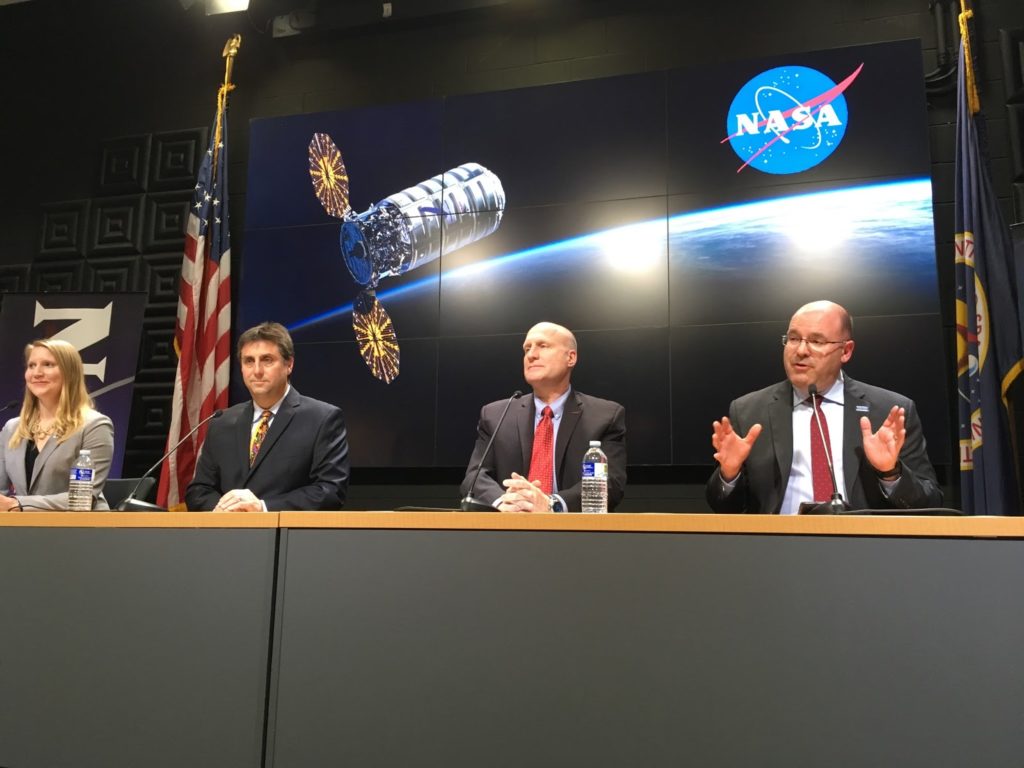 |
| Antares NG-11 post launch briefing at NASA Wallops |



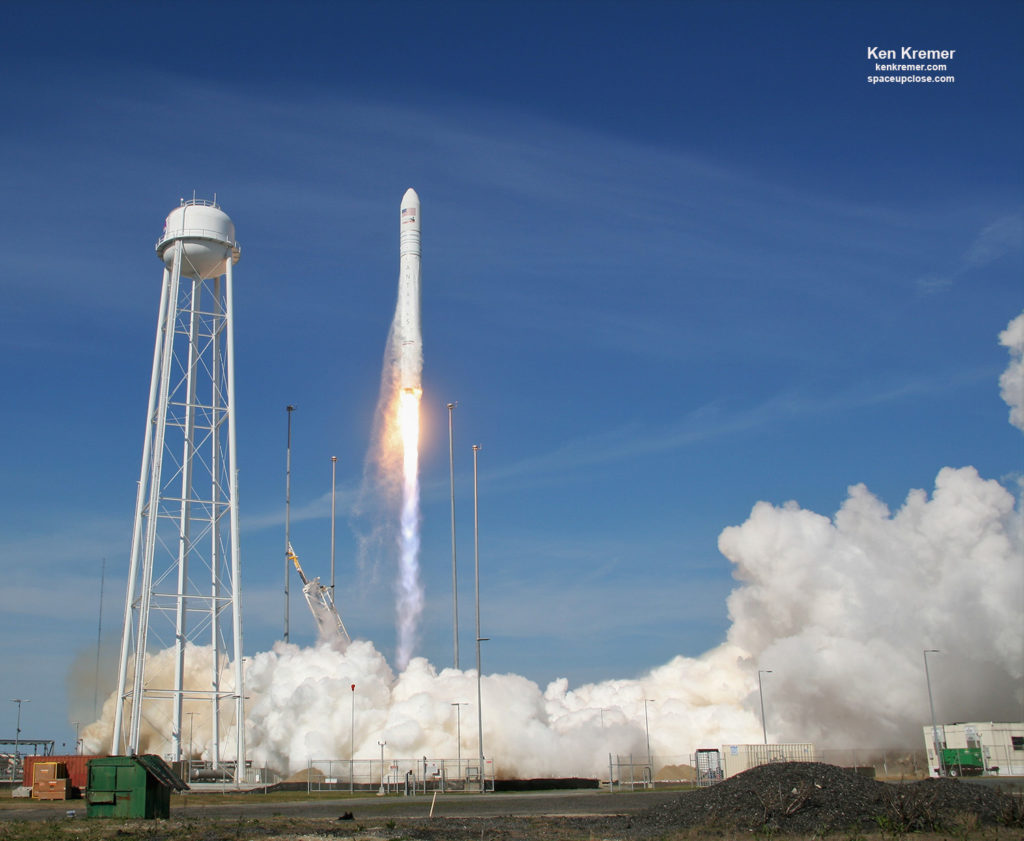
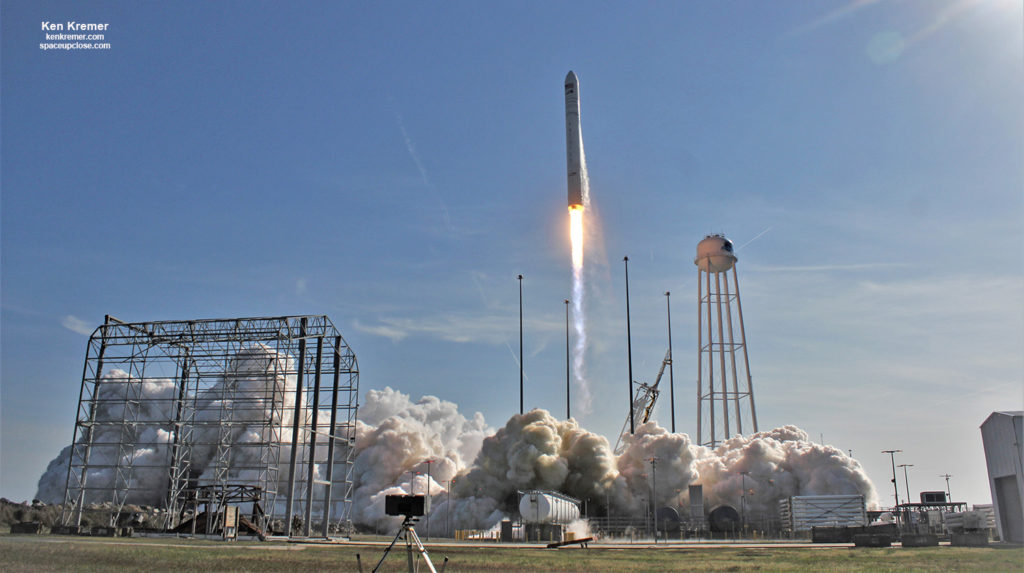
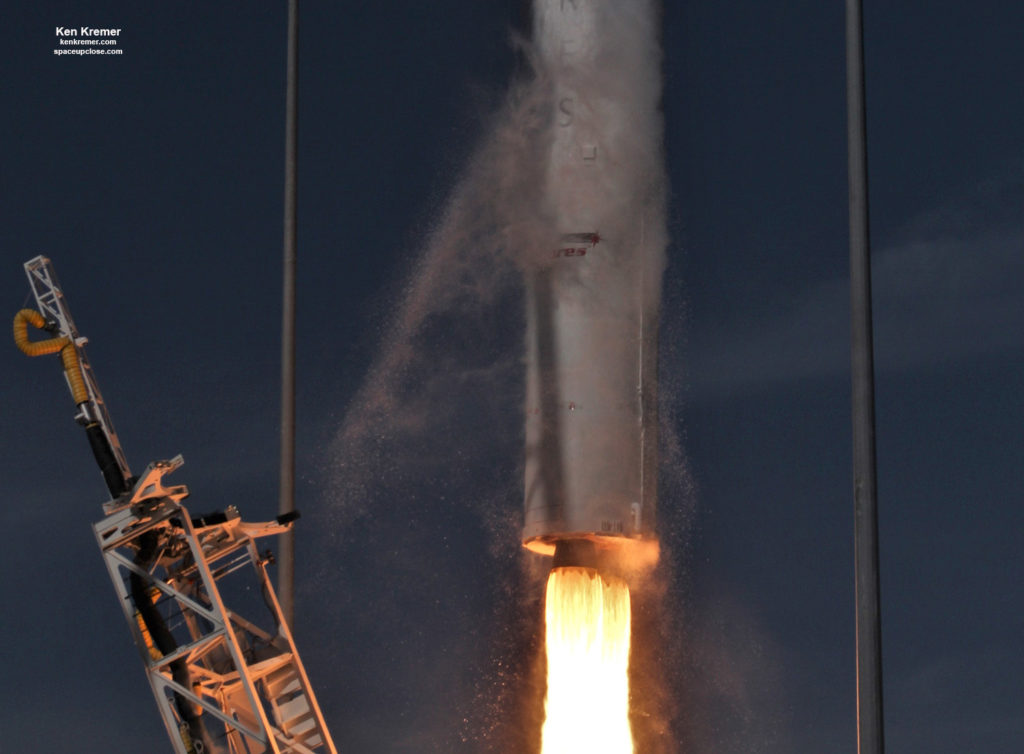
Hello,
Those pictures are incredible! I am excited about the research about life in space for astronauts.
Greetings, Tamara